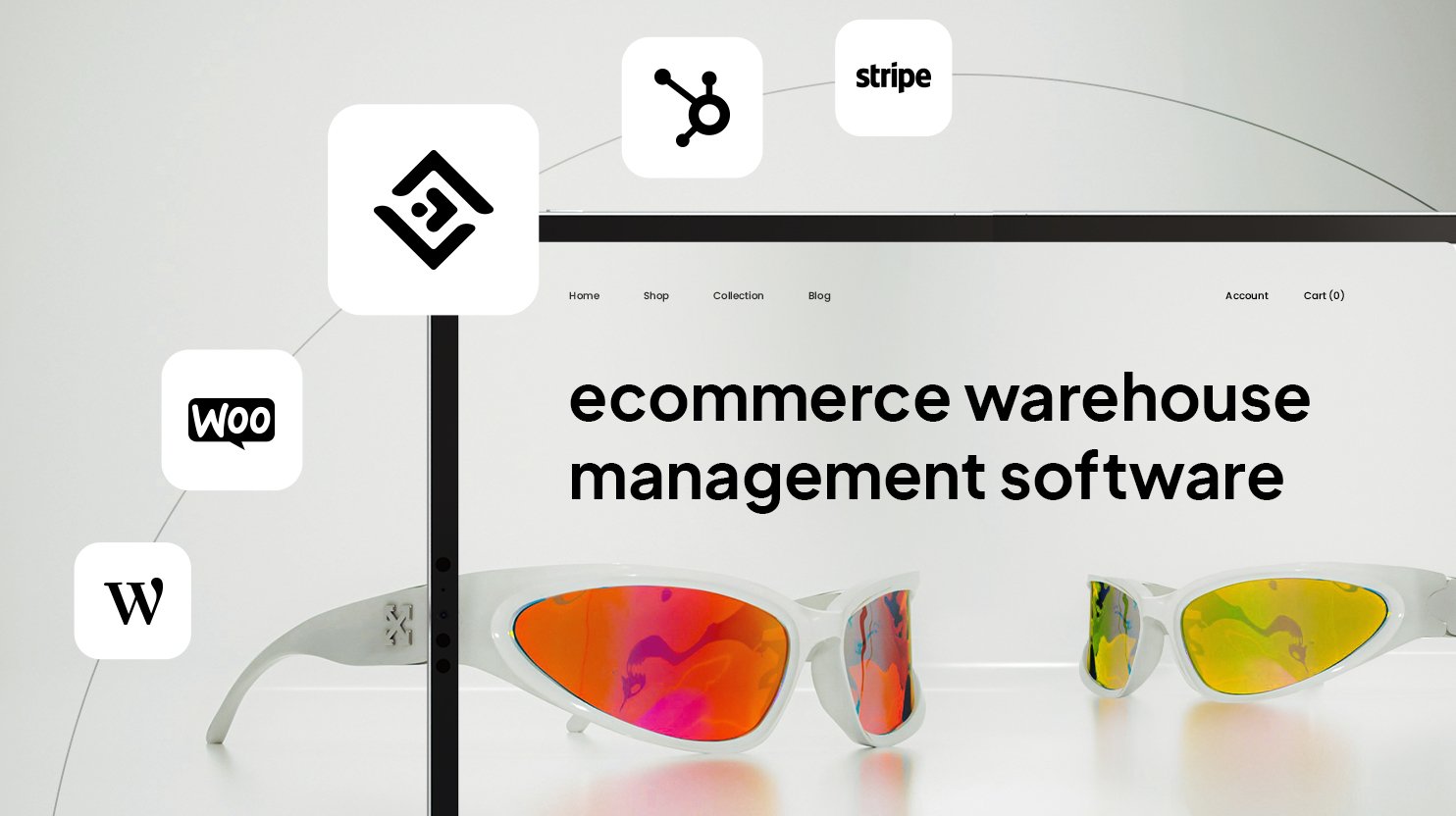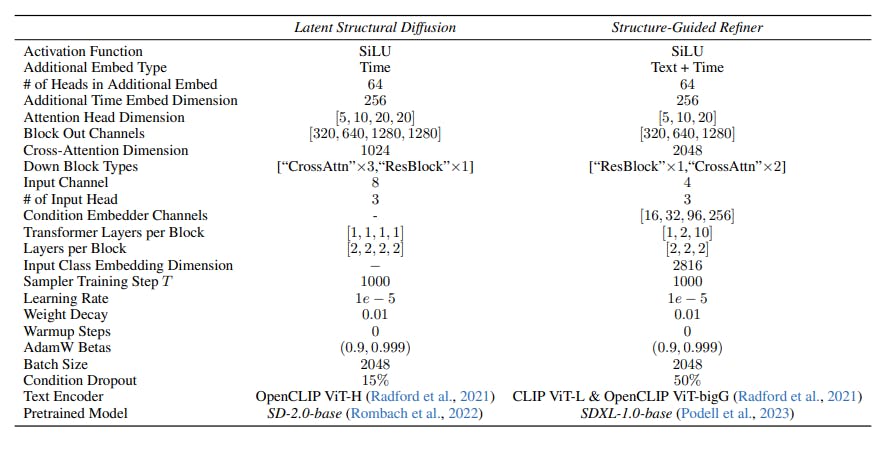Ecommerce businesses need smart tools to keep their warehouses running smoothly. Warehouse management software helps online stores track inventory, process orders, and ship products faster. These systems can boost efficiency and cut costs for ecommerce companies of all sizes.
Managing a warehouse for an online store can be tricky. There’s a lot to keep track of – from counting stock to packing boxes. The right software makes this job much easier. It can show real-time inventory levels, guide workers to pick items quickly, and even help plan the best shipping routes.
This article will help you understand how ecommerce warehouse management software can optimize inventory tracking, streamline order fulfillment, and enhance overall efficiency. By exploring 13 top software options, you will learn about key features, benefits, and considerations to select the best solution for your business needs.
Create your online store in minutes!
Looking to sell online? Develop and launch your store with 10Web AI Ecommerce Website Builder.
FAQ
What is WMS?
Warehouse Management Software (WMS) is a digital solution designed to optimize warehouse operations, including inventory management, order fulfillment, and shipping. It helps streamline processes, reduce errors, and improve overall efficiency in managing warehouse resources.
How to choose a WMS?
When selecting a WMS, consider factors such as your specific business needs, scalability, ease of integration with existing systems, and user-friendliness. Additionally, evaluate the software’s features, customer support, and pricing to ensure it aligns with your operational goals.
What features to look for?
Key features to look for in a WMS include real-time inventory tracking, order management, reporting and analytics, barcode scanning, and integration capabilities with ecommerce platforms. These features help improve accuracy, speed, and visibility throughout the supply chain.
How to improve inventory accuracy?
To enhance inventory accuracy, implement regular cycle counts, utilize barcode or RFID technology for tracking, and ensure proper training for staff on inventory management procedures. Automated systems can also help minimize human error and provide real-time updates.
What are the costs involved?
The costs of implementing a WMS can vary widely based on the software selected, the size of your warehouse, and the complexity of your operations. Typical expenses include software licensing or subscription fees, hardware costs, training, and ongoing maintenance.
Can WMS integrate with ecommerce platforms?
Yes, most modern WMS solutions are designed to integrate seamlessly with popular ecommerce platforms, allowing for real-time updates on inventory levels, orders, and shipping. This integration helps streamline operations and improve customer satisfaction through accurate order fulfillment.
What are the benefits of using WMS?
Utilizing a WMS can lead to increased operational efficiency, reduced labor costs, improved inventory accuracy, and faster order processing times. Additionally, it enhances visibility into warehouse operations, enabling better decision-making and resource allocation.
How to set up a warehouse?
Setting up a warehouse involves several key steps, including defining the layout for optimal workflow, selecting appropriate storage solutions, and implementing inventory management systems. It’s also important to establish processes for receiving, storing, and shipping products.
What are the best practices for warehousing?
Best practices for warehousing include organizing inventory logically, implementing efficient picking and packing processes, maintaining a clean and safe environment, and regularly reviewing performance metrics. Continuous training and process optimization are also crucial for success.
How to manage shipping effectively?
Effective shipping management involves optimizing packaging, choosing reliable carriers, and using technology to track shipments in real-time. Establishing clear communication with customers regarding shipping times and updates can also enhance their experience and satisfaction.
Benefits of ecommerce warehouse management software
Ecommerce warehouse management software offers key advantages for online retailers. It streamlines operations and improves inventory tracking.
Increased efficiency
Ecommerce warehouse management software boosts efficiency in several ways. It automates many manual tasks, saving time and reducing errors. The software creates optimal pick paths for workers, speeding up order fulfillment. It also helps schedule staff more effectively based on order volume.
Barcode scanning and RFID tags enable quick and accurate item tracking. This cuts down on lost or misplaced inventory. The software can also generate shipping labels and packing slips automatically. This makes the packing and shipping process much faster.
Real-time updates keep everyone on the same page. Managers can see order status, stock levels, and worker productivity at a glance. This allows for quick problem-solving and better decision-making.
Enhanced inventory control
Better inventory control is a major benefit of ecommerce warehouse management software. The system tracks stock levels in real-time across all storage locations. This prevents stockouts and overselling. You’ll know exactly when to reorder products.
The software can forecast demand based on sales history and trends. This helps you keep the right amount of each item on hand. You won’t tie up cash in excess inventory or miss sales due to shortages.
Lot tracking and expiration date management are easier with this tool. You can ensure older stock gets used first, reducing waste. The system can also flag slow-moving items so you can run promotions or stop reordering them.

Create your online store in minutes!
Looking to sell online? Develop and launch your store with 10Web AI Ecommerce Website Builder.
Key features to look for
When choosing ecommerce warehouse management software, certain features can make a big difference in your operations. These tools can help you track inventory and work with other systems smoothly.
Real-time tracking
Real-time tracking lets you see what’s happening in your warehouse right now. You can check stock levels at any time. This helps you avoid running out of items.
The software shows you where products are in the warehouse. You can find items faster when it’s time to pack orders. This makes your work quicker and more accurate.
Real-time tracking also helps with returns. You can see when items come back and update your stock count right away. This keeps your inventory numbers correct.
Some systems use barcodes or RFID tags to track items. Workers scan these as they move products around. This updates the system without extra work.
Integration capabilities
Integration capabilities let your warehouse software work with other tools you use. This can include your online store, shipping software, and accounting systems.
When your systems talk to each other, you save time. Orders from your store can go straight to the warehouse. This means less manual data entry and fewer mistakes.
Good integration also helps with reporting. You can pull data from different sources into one place. This gives you a clear picture of how your business is doing.
Look for software that connects with the platforms you already use. This makes setup easier. It also means you won’t have to change your whole system.
Cost of Ecommerce WMS
The cost of implementing a warehouse management system varies widely depending on the size of your business, system complexity, and deployment method.
Cloud-based WMS options often come with lower upfront costs due to their subscription-based pricing models, making them a popular choice for small to mid-sized ecommerce businesses. On-premise systems, while more customizable, typically require significant upfront investment in hardware and installation.
Other costs to consider include training for your team, ongoing maintenance, and potential add-ons for advanced features like RFID tracking or multi-warehouse management. While the initial expense may seem high, investing in a WMS can lead to significant long-term savings by reducing errors, optimizing inventory, and speeding up order fulfillment.
When evaluating costs, balance your budget with the potential return on investment (ROI) the software can bring to your business through improved efficiency and reduced operational challenges.
Selecting the right ecommerce warehouse management software
Choosing the ideal ecommerce warehouse management software requires a thoughtful evaluation of your business operations and the features that best support your needs. With numerous options available, narrowing down the right solution involves understanding your specific requirements and carefully assessing key factors.
Start by analyzing your current operations. Consider the size of your warehouse, the volume of orders you process daily, and whether you operate multiple storage locations. These insights will help you identify software that aligns with your operational complexity and scale.
Evaluate how well the software integrates with your existing systems, such as your online store, shipping platforms, and accounting tools. Seamless integration reduces manual tasks, minimizes errors, and ensures smoother workflows.
Look for essential features like real-time inventory tracking to prevent stockouts and overselling, as well as tools to manage multiple warehouses efficiently. Order fulfillment capabilities—such as picking, packing, and shipping tools—are critical for speeding up processes and meeting customer expectations.
Consider advanced features like reporting and analytics, which can offer insights into inventory trends and operational performance. These tools empower data-driven decisions and help optimize your supply chain management.
Lastly, assess the level of customer support provided. Reliable assistance through phone, email, or chat can be invaluable when resolving issues or learning to use new features.
Taking the time to evaluate these factors will ensure you select a warehouse management system that enhances efficiency, supports growth, and meets the unique demands of your ecommerce business.

Create your online store in minutes!
Looking to sell online? Develop and launch your store with 10Web AI Ecommerce Website Builder.
Top 13 ecommerce warehouse management software
Let’s explore the top ecommerce warehouse management software solutions, highlighting their features, benefits, and potential drawbacks. From inventory tracking and order fulfillment to integrations with popular ecommerce platforms, these tools cater to businesses of various sizes and industries. Whether you’re a small retailer or a large logistics provider, this list will help you find the right software to optimize your warehouse operations.
1. ShipBob
ShipBob offers ecommerce warehouse management software for businesses of all sizes. Their system helps you track inventory, manage orders, and ship products efficiently.
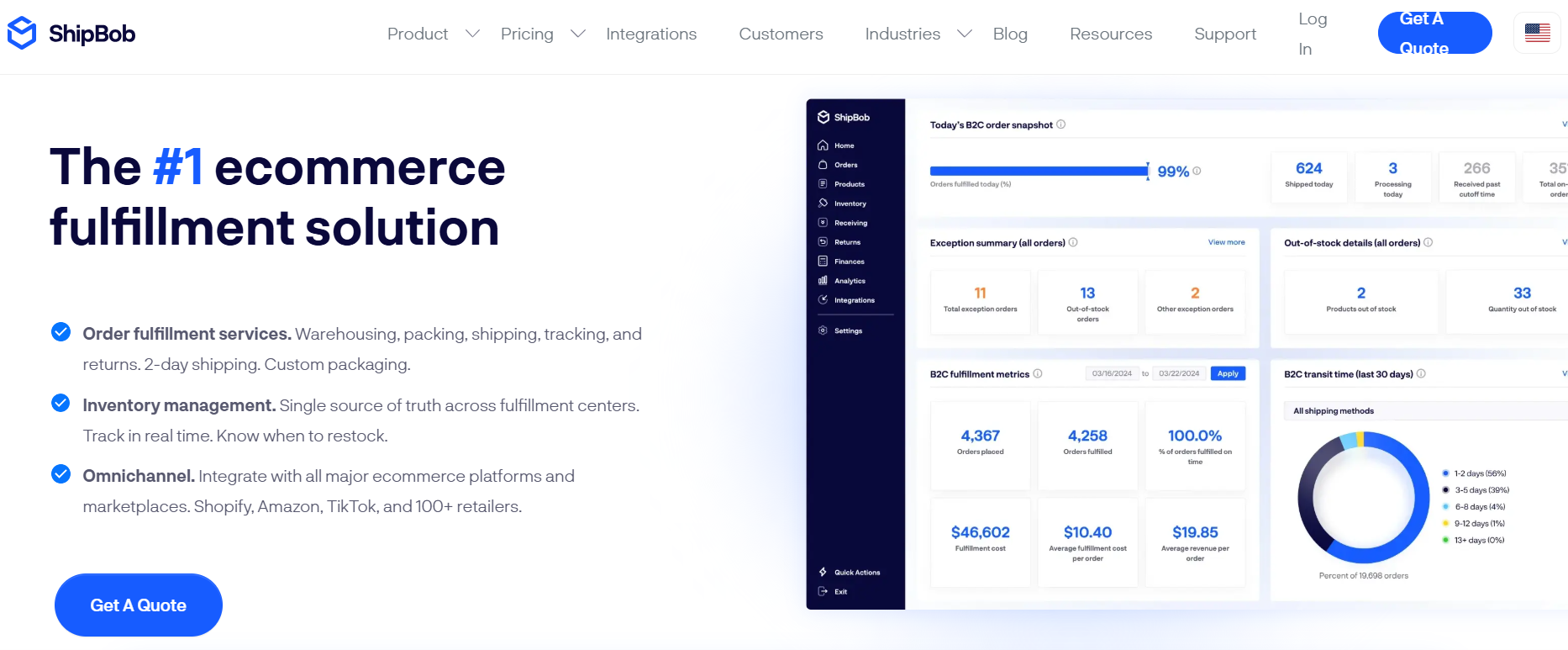
ShipBob’s software connects to popular online stores like Shopify and Amazon. It lets you see your stock levels and sales data in one place. You can also set up automatic reorder alerts to avoid running out of items.
The platform handles order processing from start to finish. It creates packing lists, prints shipping labels, and updates customers on their order status.
| Pros | Cons |
|---|---|
| Easy to use interface | Can be pricey for small businesses |
| Integrates with many ecommerce platforms | Limited customization options |
| Offers multiple warehouse locations | May have longer shipping times in some areas |
ShipBob works well for small to medium-sized online retailers. Clothing brands, beauty companies, and food sellers often use their services. It’s a good fit for businesses that want to grow without managing their own warehouses.
2. Fishbowl Inventory
Fishbowl Inventory is a popular warehouse management software for ecommerce businesses. It helps you keep track of your stock across multiple locations. The software connects with QuickBooks and Xero for seamless accounting.
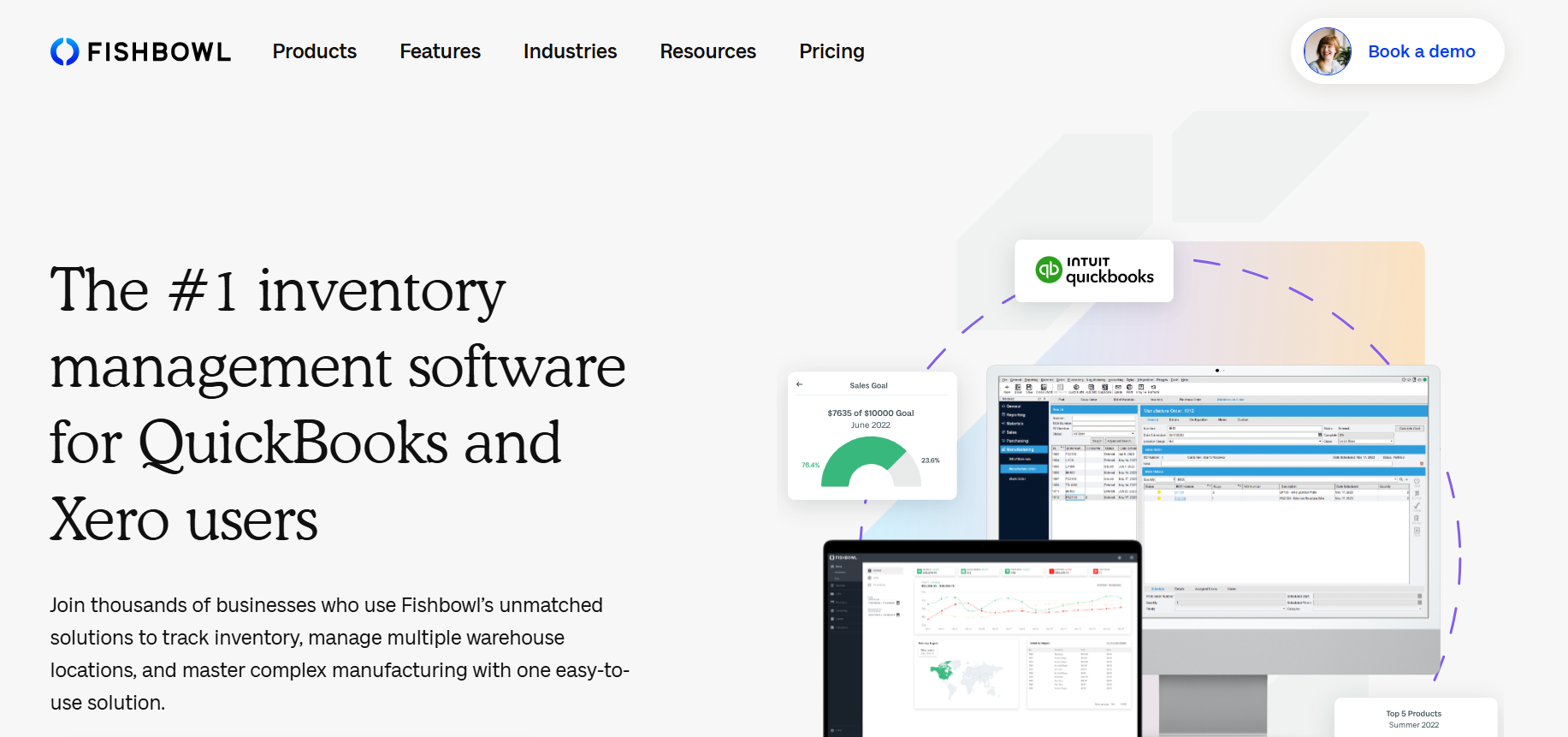
You can use Fishbowl to process customer orders quickly. It shows you updates, issues, and shipping details in one place. This makes fulfilling orders easier, whether from physical warehouses or dropshipping.
Fishbowl offers features for manufacturing too. You can manage production schedules and track work orders. It also monitors how you use raw materials.
| Pros | Cons |
|---|---|
| Integrates with QuickBooks | May be complex for very small businesses |
| Handles multiple warehouses | Requires initial setup time |
| Includes manufacturing features | Could be pricey for some users |
Small and medium-sized businesses often use Fishbowl. It’s good for companies that make or sell physical products. Retailers, wholesalers, and manufacturers find it useful.
3. NetSuite WMS
NetSuite WMS is a warehouse management system that helps you run your warehouse smoothly. It’s part of NetSuite’s bigger business software package.
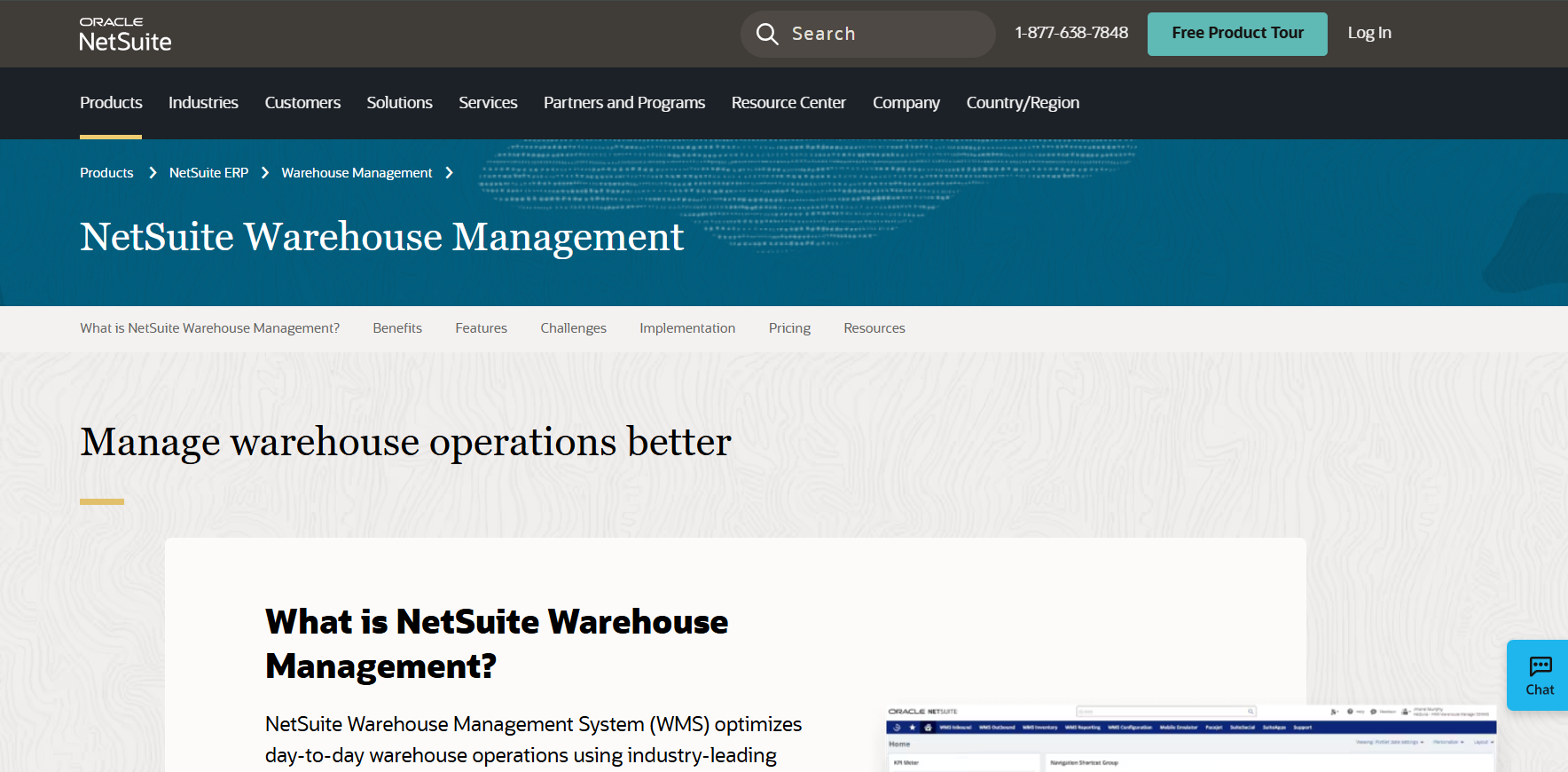
With NetSuite WMS, you can track your inventory using barcodes and mobile devices. This makes it easier to find and move products around your warehouse.
The software helps you decide where to put new items and how to pick items for orders. It also manages tasks for your workers and keeps track of returned items.
NetSuite WMS works well for medium and large businesses. It’s good for companies that sell through many channels, like stores and online.
| Pros | Cons |
|---|---|
| Easy to see all warehouse info in one place | Can be complex for small businesses |
| Works with other NetSuite tools | Might be pricey for some companies |
| Can handle many warehouses | Needs time to set up and learn |
4. Cin7
Cin7 is an ecommerce warehouse management software that helps you manage inventory across multiple sales channels. It gives you a real-time view of your products in different systems, marketplaces, and regions.
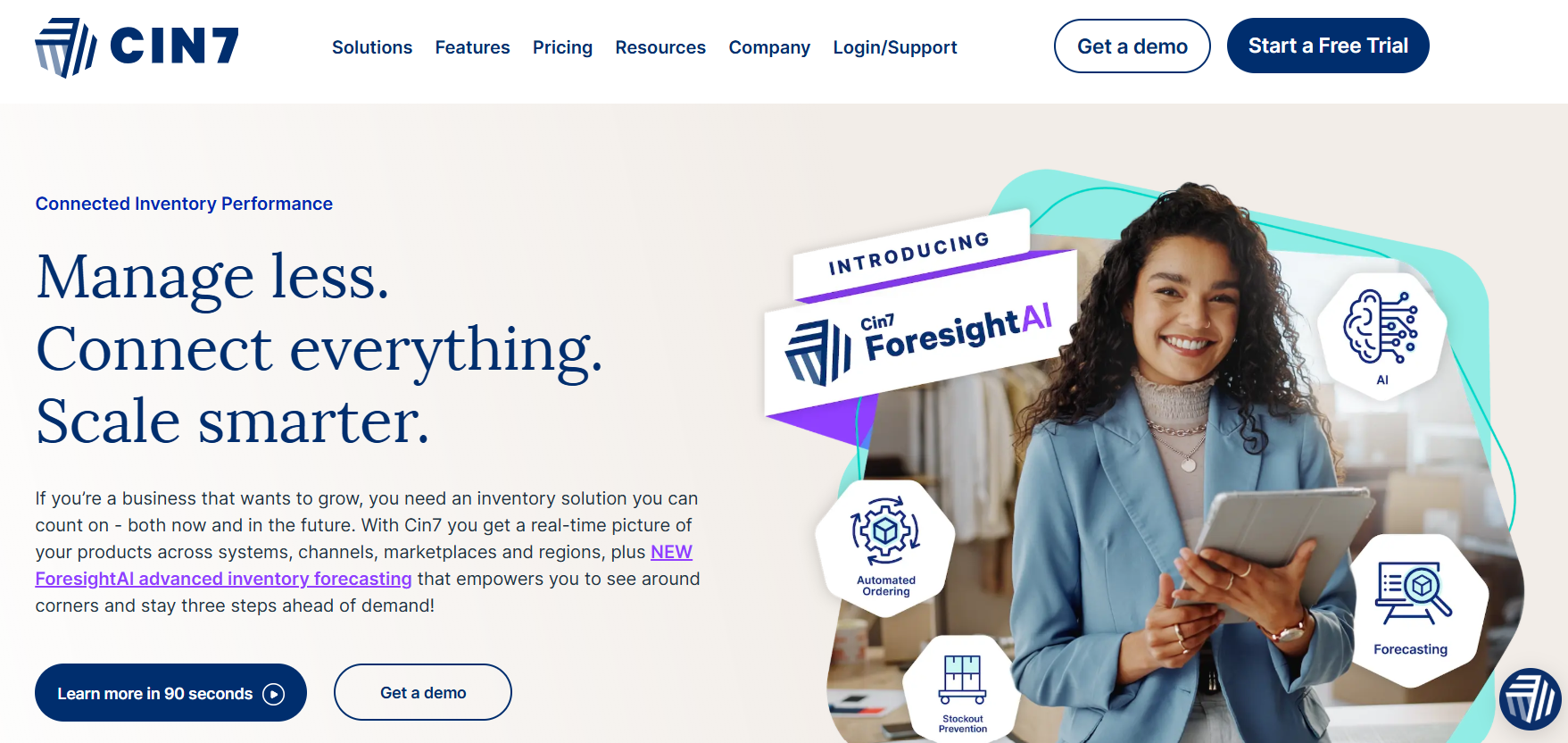
Cin7 offers features like inventory tracking, order management, and integration with popular ecommerce platforms. You can use it to keep track of stock levels and handle orders from various online stores.
The software works well for businesses of different sizes, from small operations to large companies. It’s useful for retailers, wholesalers, and manufacturers who sell products online.
Cin7 is good for businesses that need to manage stock in multiple warehouses. It also supports different currencies, which is helpful if you sell in more than one country.
| Pros | Cons |
|---|---|
| Real-time inventory updates | May be complex for very small businesses |
| Supports multiple sales channels | Pricing can be high for some users |
| Integrates with popular e-commerce platforms | Learning curve for new users |
5. Zoho Inventory
Zoho Inventory helps you manage your online store’s stock. It’s a cloud-based tool that works well for small and medium-sized businesses. You can track items across multiple warehouses and sales channels.
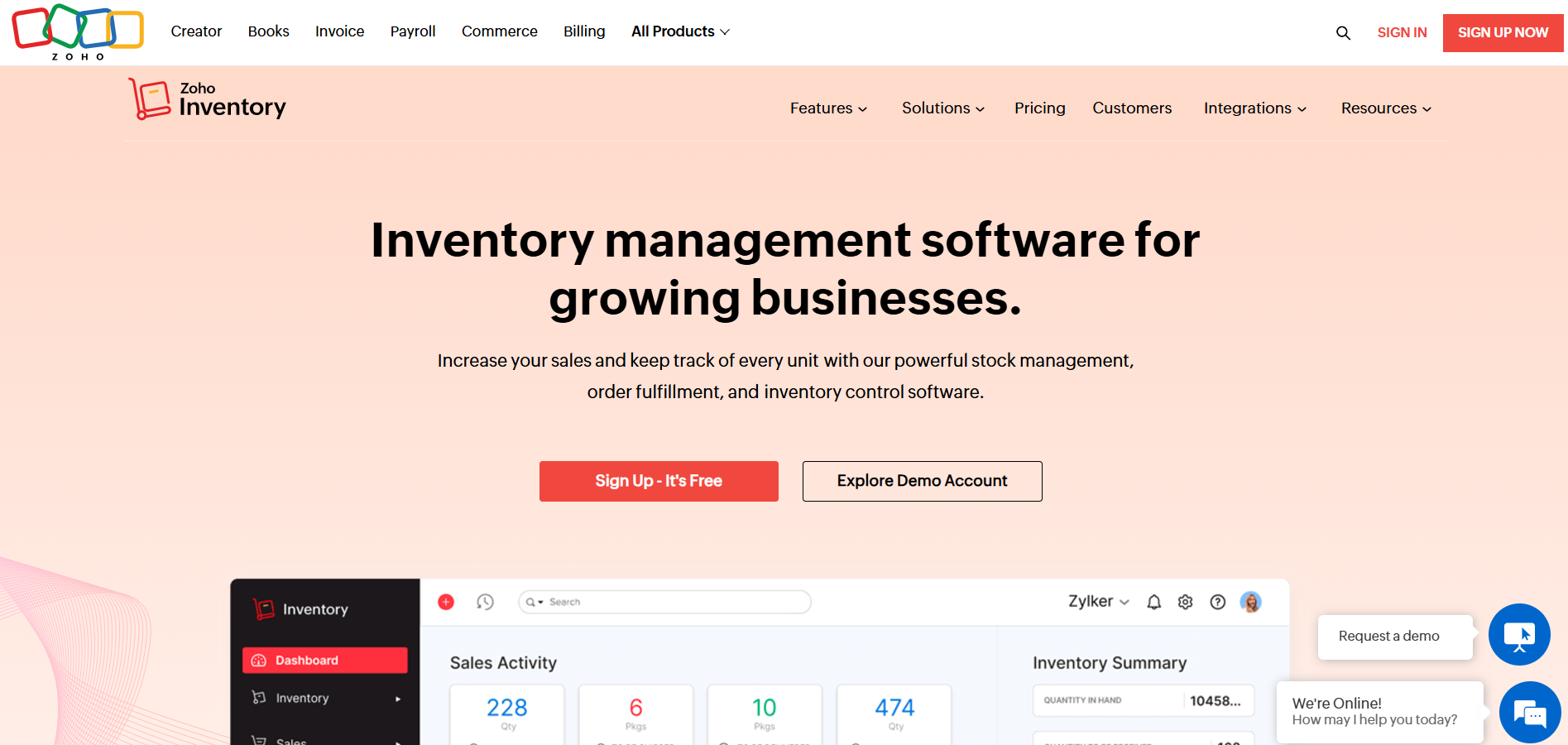
With Zoho Inventory, you can see your stock levels in real-time. This helps you avoid running out of popular products. You can set up alerts when stock gets low, so you know when to reorder.
The software lets you create and track orders easily. You can also manage returns and refunds. It integrates with many ecommerce platforms, making it simple to sync your data.
Zoho Inventory offers features for different industries. Retailers, wholesalers, and manufacturers can all benefit from its tools. It’s especially good for businesses that sell online and in physical stores.
| Pros | Cons |
|---|---|
| Easy to use interface | Limited features in free plan |
| Integrates with many platforms | Can be slow during peak times |
| Affordable pricing options | Some advanced features cost extra |
6. 3PL Central
3PL Central offers ecommerce warehouse management software for third-party logistics providers. You can use it to manage your warehouse operations and fulfill orders for online retailers.
The software helps you track inventory, process orders, and manage shipping. It connects with popular ecommerce platforms and shipping carriers. This makes it easier to handle orders from different sales channels.
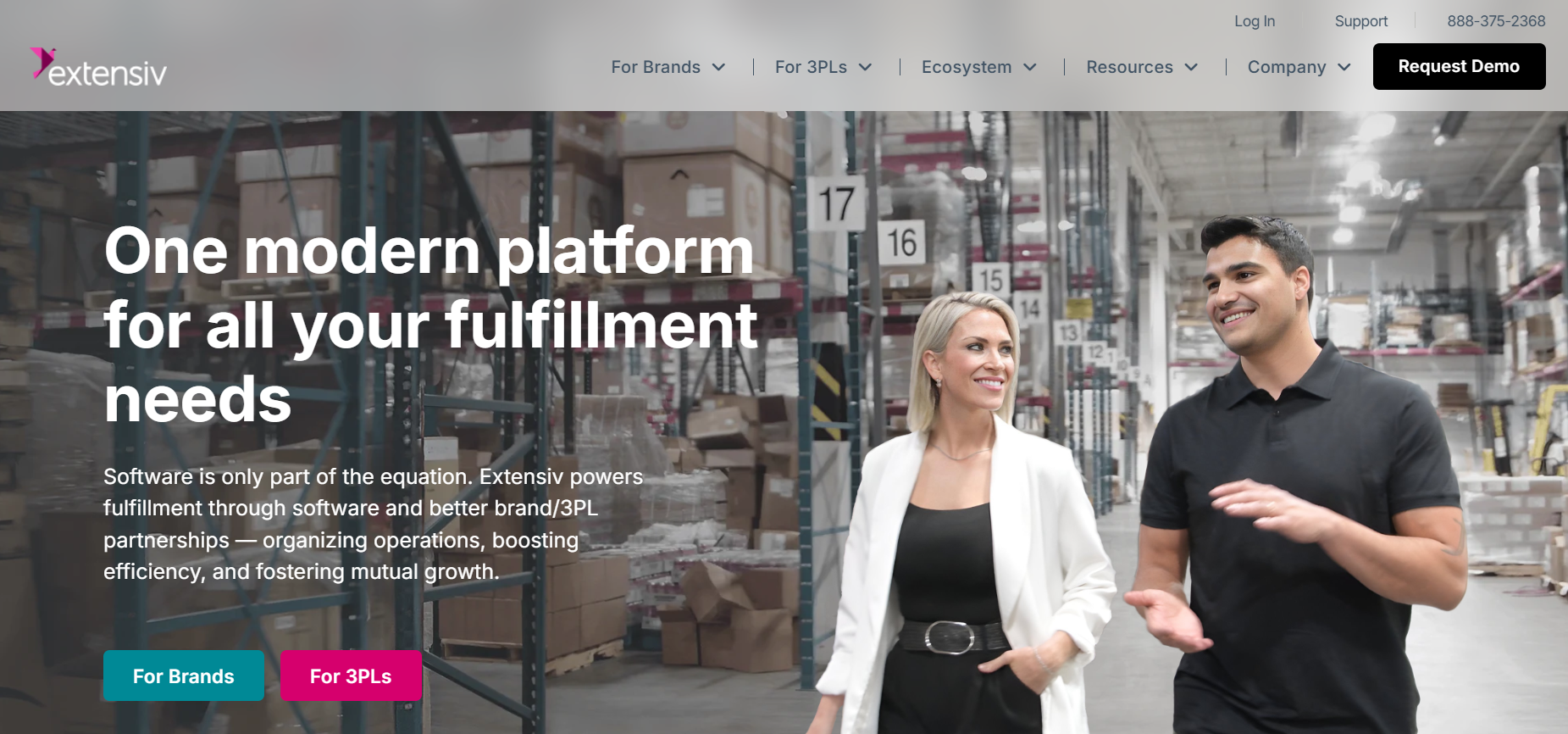
3PL Central is made for logistics companies that store and ship products for other businesses. It’s useful for warehouses that deal with high volumes of ecommerce orders.
Many types of companies use this software. These include fulfillment centers, distribution warehouses, and retail logistics providers.
The tool works well for medium to large 3PL companies. It can handle complex operations with multiple clients and warehouses.
| Pros | Cons |
|---|---|
| Designed for 3PL needs | May be complex for small operations |
| Integrates with many platforms | Can be pricey for some businesses |
| Supports high-volume order processing | Might require staff training |
7. Inflow Inventory
Inflow Inventory is a software system that helps small businesses manage their stock. It’s useful for ecommerce, manufacturing, and warehouse operations.
The software lets you track products across different locations. You can scan barcodes to update stock levels quickly. This keeps your inventory data current and accurate.
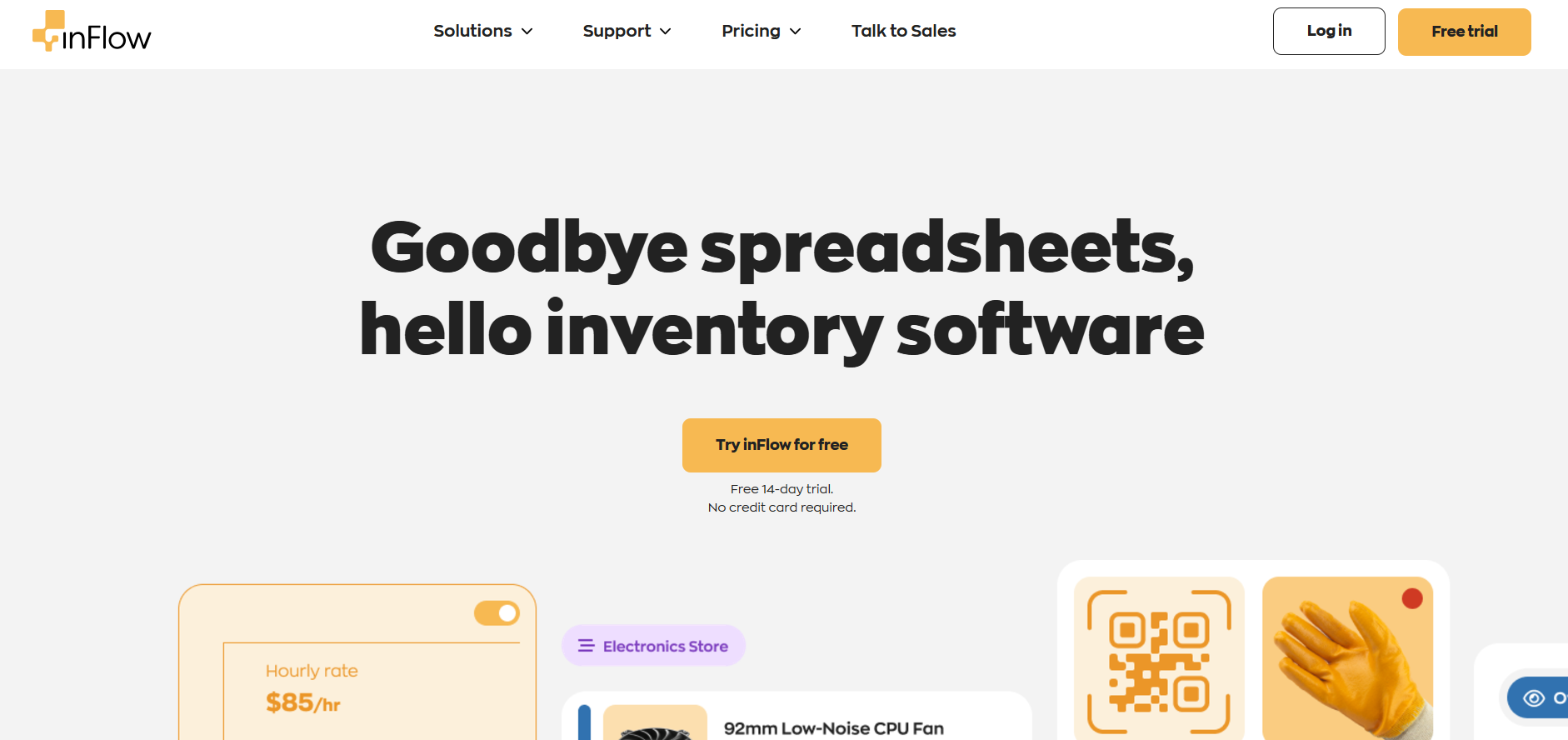
Inflow offers tools for purchasing, sales, and reporting. You can create purchase orders, manage sales, and view reports on your inventory. This helps you make smart decisions about what to stock.
The system works well for small to medium-sized businesses. It’s used by companies in retail, wholesale, and light manufacturing. Inflow is good for businesses that need a simple way to track their products.
| Pros | Cons |
|---|---|
| Easy to use | Can be pricey for some small businesses |
| Good for multiple locations | May lack some advanced features |
| Includes barcode scanning | Requires setup time |
8. SkuVault
SkuVault Core is a cloud-based inventory and warehouse management system for ecommerce businesses. It helps you keep track of your products and manage your warehouse more efficiently.
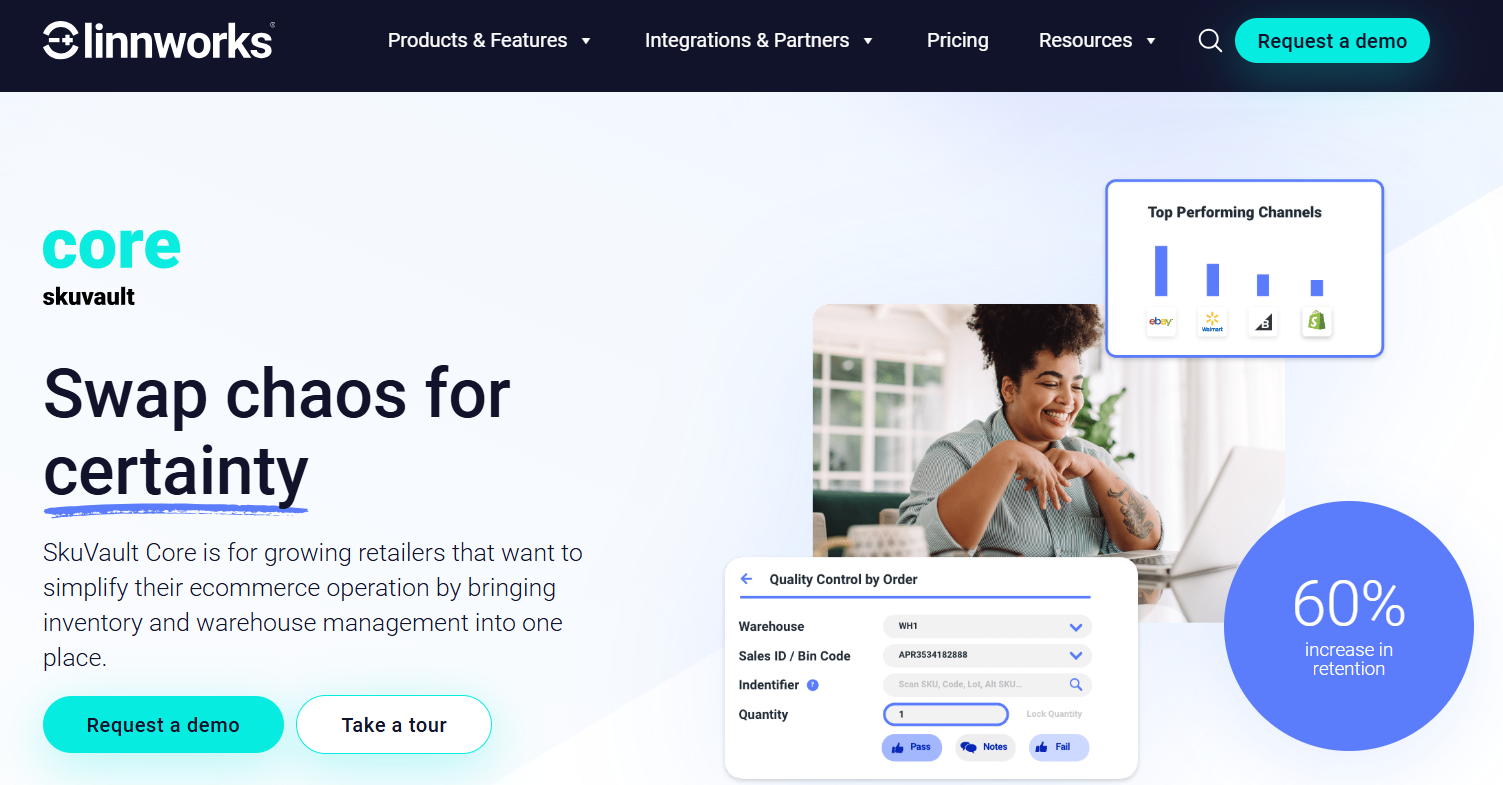
The software offers real-time inventory updates, so you always know what’s in stock. It also helps with picking and packing orders faster and more accurately.
SkuVault Core is made for growing online retailers. It’s useful for businesses that sell on multiple channels like Amazon, eBay, and their own websites.
Many types of e-commerce companies use SkuVault Core. This includes fashion, electronics, and home goods sellers. It’s a good fit for small to medium-sized businesses that want to improve their warehouse operations.
| Pros | Cons |
|---|---|
| Real-time inventory updates | May be complex for very small businesses |
| Helps reduce out-of-stocks | Requires time to set up and learn |
| Improves order accuracy | Some features may need extra training |

Create your online store in minutes!
Looking to sell online? Develop and launch your store with 10Web AI Ecommerce Website Builder.
9. IWMS
IWMS is a warehouse management system that helps businesses handle their inventory and orders. It’s made by a company called IWMS. This software can work with online stores to make shipping faster and easier.
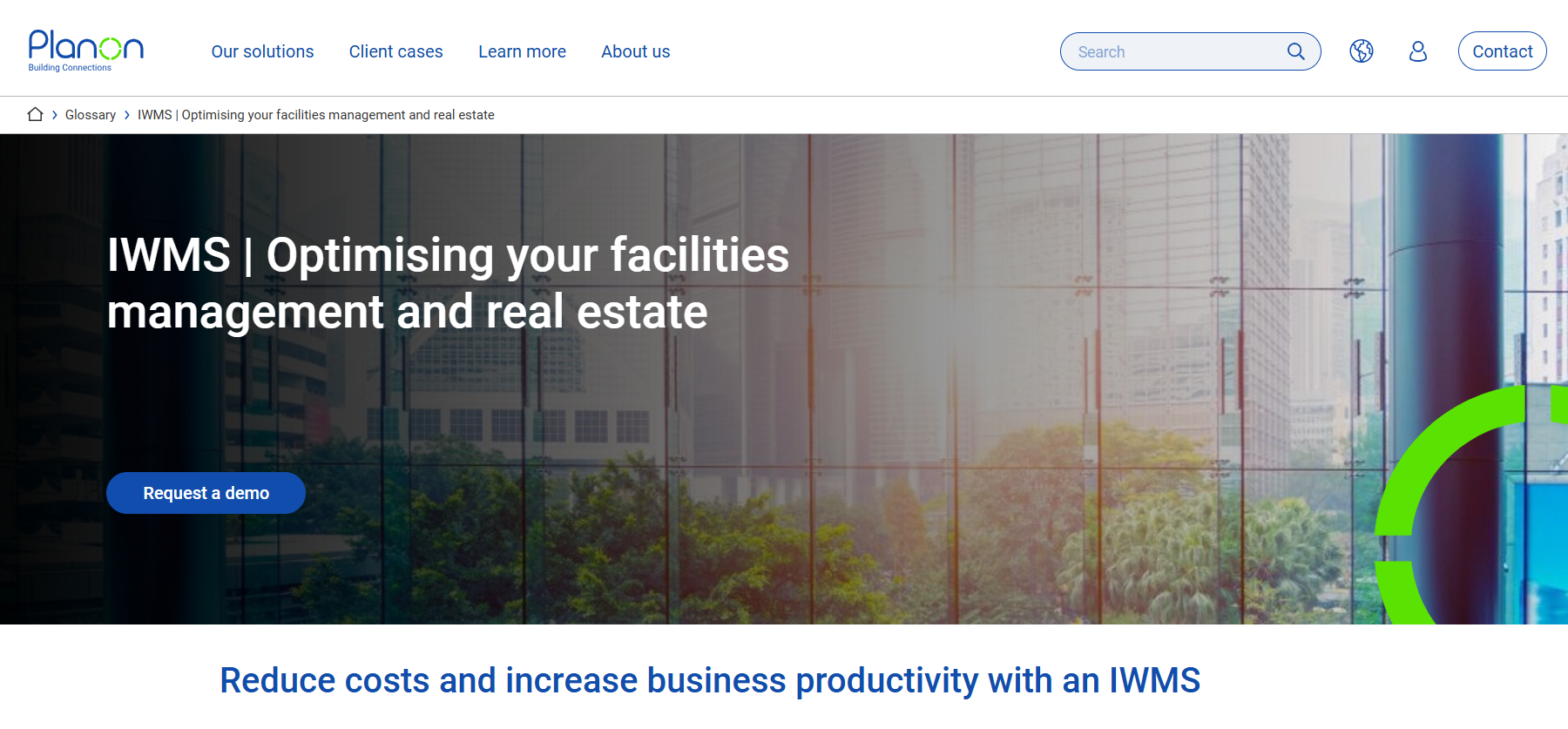
IWMS has tools to track products in your warehouse. You can see where items are stored and how many you have left. It also helps you pick and pack orders quickly.
The system works well for both small and big companies. It’s used by retailers, wholesalers, and manufacturers. IWMS is good for businesses that sell a lot online and need to ship orders fast.
| Pros | Cons |
|---|---|
| Easy to use | Can be pricey for small businesses |
| Helps with ecommerce warehouse management software | Might need training to use all features |
| Works with many online stores | Updates may take time to learn |
10. ShipHero
ShipHero is a warehouse management software built for ecommerce brands and 3PLs. It helps you manage your order fulfillment process more efficiently.
The software offers one-click integrations with popular platforms like Shopify. You can track orders and send shipment notifications easily. It also includes features for automating tasks like warehouse routing and address validation.
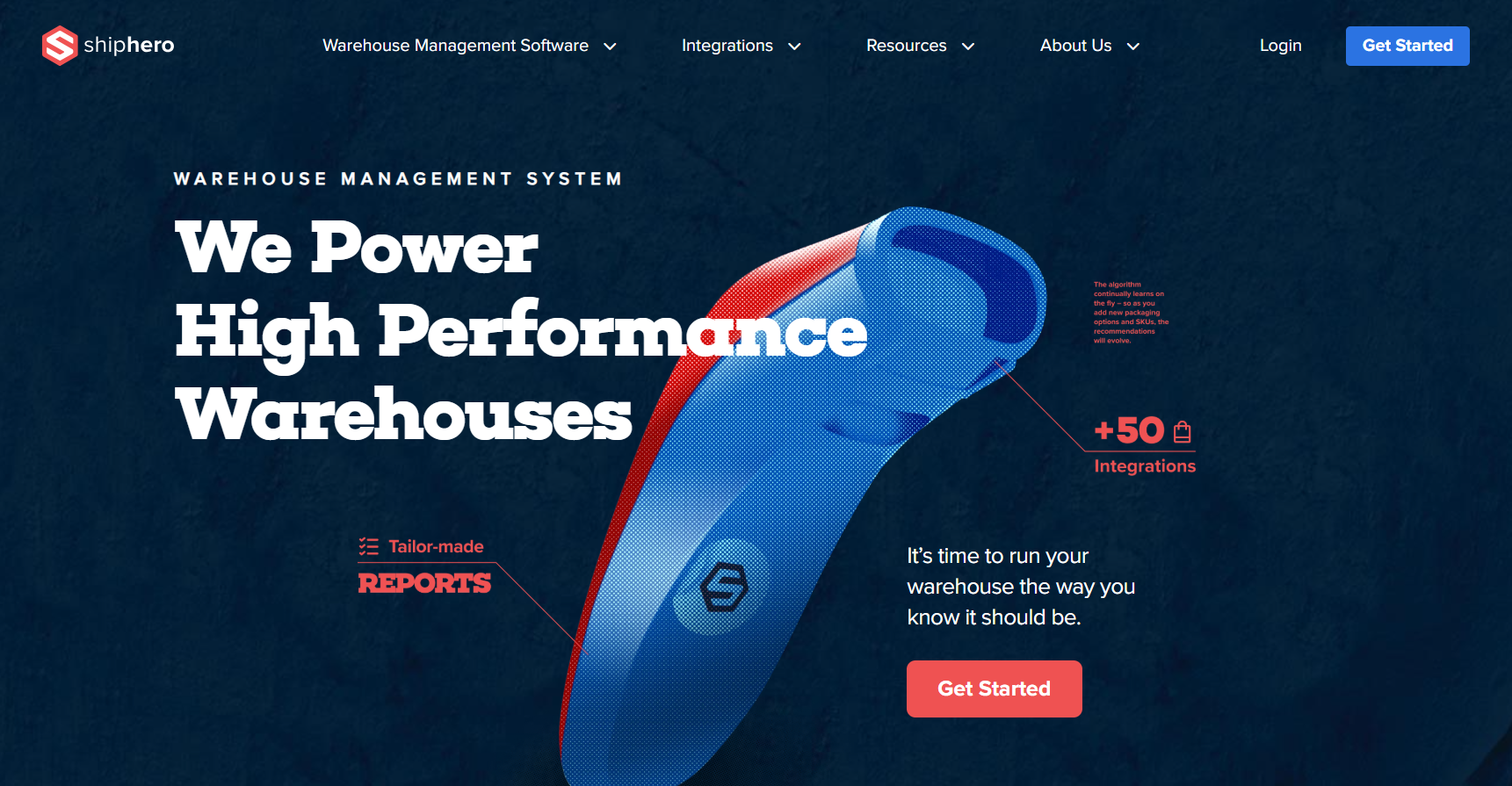
ShipHero’s main users are ecommerce businesses and third-party logistics providers. It’s suitable for companies of various sizes in the retail and distribution industries.
Users report faster picking times and increased productivity with ShipHero. One customer mentioned that a single person can pick 70-80 orders per hour using the system.
| Pros | Cons |
|---|---|
| Fast order picking | Learning curve for new users |
| Easy integrations | May be pricey for small businesses |
| Automation features | Some features might be complex |
11. Veeqo
Veeqo is a warehouse management software for ecommerce businesses. It helps you handle product bundles across different sales channels. You can track individual items in bundles to avoid overselling.
The software connects with popular platforms like Amazon, Shopify, eBay, and Etsy. It syncs your inventory in real-time, so you always know what’s in stock.
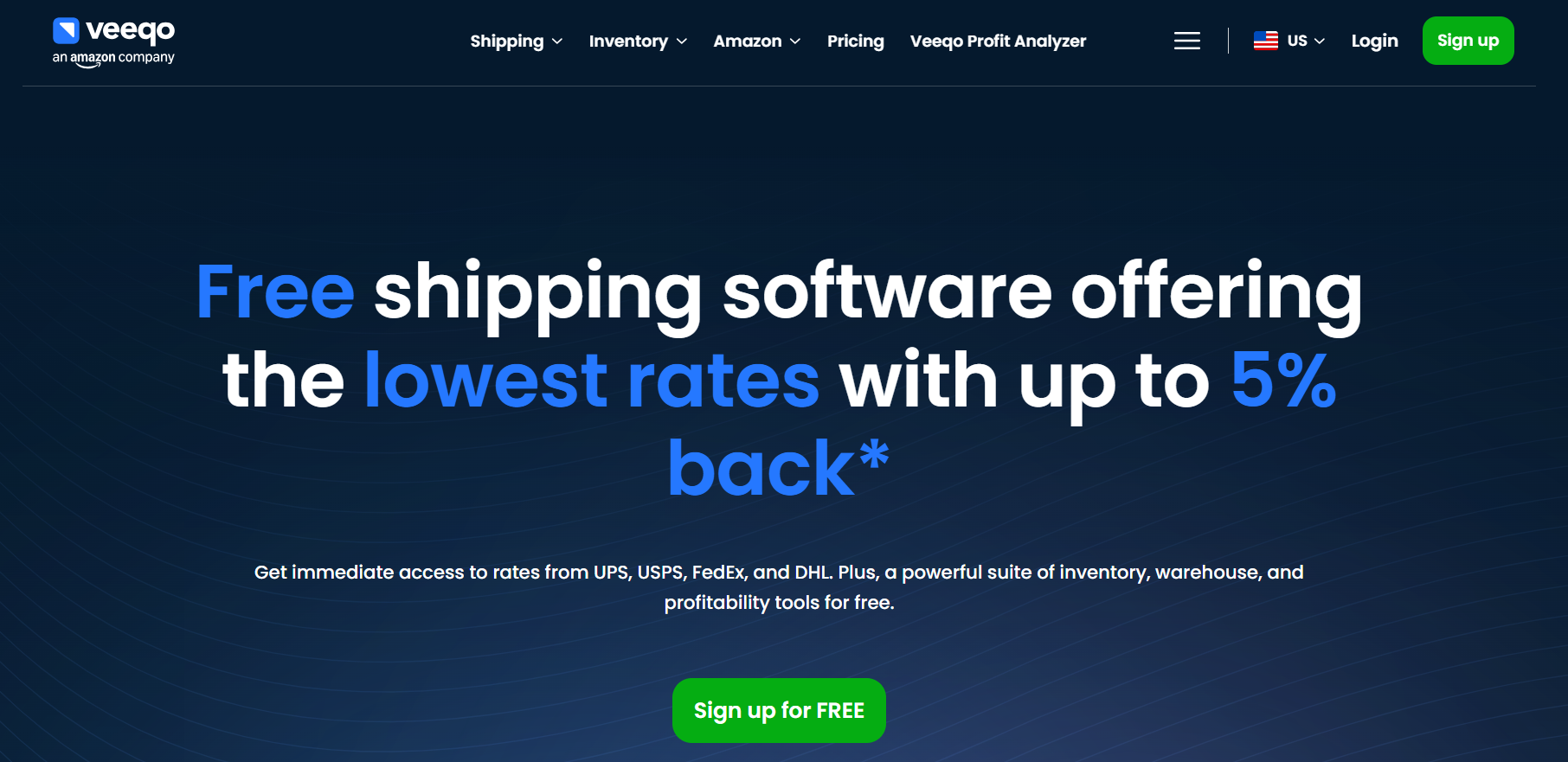
Veeqo offers tools for picking, packing, and shipping orders. You can print shipping labels in bulk and use multiple carriers. This speeds up your order fulfillment process.
The software also provides reporting features. You can track sales, picking performance, and inventory levels. It even helps with inventory forecasting to plan for future needs.
Veeqo is useful for online retailers who sell on multiple channels. It’s a good fit for small to medium-sized ecommerce businesses looking to streamline their operations.
| Pros | Cons |
|---|---|
| Manages product bundles | May have a learning curve |
| Real-time inventory syncing | Could be pricey for very small businesses |
| Bulk shipping label printing | Some features may be complex for beginners |
Integrating ecommerce platforms with warehouse management software
Connecting online stores with warehouse systems helps businesses manage inventory and orders better. This integration streamlines operations and improves customer service.
Shopping cart integration
When a customer places an order on an ecommerce website, the shopping cart sends that information to the warehouse management software. This link lets the warehouse know what items to pick and pack right away.
The software updates inventory levels in real-time. This stops overselling and keeps the online store accurate. It also helps with restocking by flagging low stock items.
Some systems can show customers the exact number of products available. This builds trust and manages expectations about delivery times.
Order processing and fulfillment
Once an order comes in, the warehouse management software takes over. It creates pick lists for workers and chooses the best packing materials.
The software can group orders to save time and cut shipping costs. It might put all orders for the same zip code together, for example.
As orders are packed, the system updates their status. This info goes back to the ecommerce platform so customers can track their packages.
Multichannel synchronization
Many businesses sell on multiple platforms like their own website, Amazon, and eBay. Ecommerce warehouse management software can sync data across all these channels.
This means when an item sells on one platform, the stock level updates everywhere. It prevents double-selling and keeps all sales channels in sync.
The software can also help with pricing. If you change a price in one place, it can update across all platforms automatically.
Some systems even help manage returns across different channels, making the process smoother for both customers and staff.
Integration Time for WMS
The time required to fully integrate a warehouse management system (WMS) into your business operations depends on several factors, including the system’s complexity, whether it’s cloud-based or on-premise, and the size of your operation. While smaller businesses may complete the process in as little as a few weeks, larger companies with more intricate operations often require several months.
For cloud-based warehouse management systems, the integration timeline is typically shorter since they don’t require extensive hardware installations. These systems usually involve configuring software, connecting it to existing platforms like ecommerce stores or shipping providers, and training employees on its use. A straightforward setup can often be completed in 2-6 weeks, depending on the level of customization needed.
For larger operations with multiple warehouses or complex workflows, integration time can extend to several months. This includes not only installing and configuring the WMS but also testing its functionality across different departments, synchronizing it with other business systems, and adapting it to specific needs like multi-location inventory tracking.
No matter the size of your business, planning for a phased implementation can help minimize disruptions. Collaborating closely with your WMS provider ensures a smooth transition and efficient deployment of the system.

Create your online store in minutes!
Looking to sell online? Develop and launch your store with 10Web AI Ecommerce Website Builder.
Inventory management in ecommerce
Inventory management is a key part of running an online store. It helps track products, manage stock levels, and keep orders flowing smoothly. Good inventory systems make it easier to grow an ecommerce business.
Real-time inventory tracking
Real-time tracking lets stores see stock levels as they change. This stops overselling and keeps customers happy. When an item sells on the website, the system updates right away. Staff can check stock from anywhere with internet access.
Most ecommerce platforms link to inventory software. This keeps product counts accurate across sales channels. If stock runs low, the system can send alerts. This helps stores reorder at the right time.
Some tools use barcodes or RFID tags to track items. These make it fast to count stock or find products in a warehouse. Mobile apps let staff update inventory on the go.
SKU management
SKUs are codes that identify each product a store sells. Good SKU systems make inventory easier to manage. Each item gets a unique code. This helps track stock levels, sales, and other data.
SKUs often include details like size, color, or style. This makes it simple to find the right item when filling orders. It also helps spot trends in what sells best.
Many tools can make SKUs automatically. This saves time when adding new products. Some systems can suggest reorder points based on sales history. This helps keep popular items in stock.
Product kitting and bundling
Kitting means grouping items to sell as a set. Bundling is similar but often includes discounts. Both can boost sales and clear out slow-moving stock.
Good inventory systems track kits as one item and as separate parts. This makes sure all pieces are in stock when filling orders. It also helps manage costs and pricing.
Some tools let stores make kits on the fly. This is great for custom orders or promotions. Others can suggest bundles based on what customers often buy together.
Kitting can save time in the warehouse. Staff can grab pre-made kits instead of picking each item. This speeds up order processing and shipping.
Warehouse automation technologies
Warehouse automation technologies are transforming how ecommerce businesses manage their operations. These tools boost speed, accuracy, and efficiency in fulfillment processes.
Automated data collection
Barcode scanners and RFID systems are key data collection tools in modern warehouses. Workers use handheld scanners to quickly log inventory as it moves through the facility. Fixed scanners on conveyor belts track items automatically.
RFID tags allow scanning multiple items at once without a direct line of sight. This speeds up receiving and shipping processes. The tags also help with real-time inventory tracking.
Mobile computers and tablets let staff access and update data on the go. They can view pick lists, check stock levels, and record tasks from anywhere in the warehouse.
Robotics and conveyor systems
Automated guided vehicles (AGVs) move products around warehouses without human drivers. They follow set paths or use sensors to navigate. AGVs can transport pallets, boxes, or entire shelving units.
Robotic arms assist with tasks like palletizing and depalletizing. They can stack boxes precisely and quickly. Some models work alongside humans to boost productivity.
Conveyor systems move items between zones in the warehouse. They can sort products into different lanes based on their destination. Advanced systems use sensors and cameras to route packages.
Picking and packing optimization
Voice picking systems guide workers through tasks using audio instructions. Staff wear headsets that tell them where to go and what to grab. They confirm actions by speaking into a microphone.
Pick-to-light systems use LED lights to show which items to pick. Lights on shelves or bins turn on to guide workers. This cuts down on errors and speeds up the picking process.
Automated storage and retrieval systems (AS/RS) bring items to workers. Robotic shuttles fetch products from high-density storage. This saves time and reduces worker movement.
Ecommerce warehouse management software often integrates with these automation tools. The software coordinates tasks and collects data from various systems.

Create your online store in minutes!
Looking to sell online? Develop and launch your store with 10Web AI Ecommerce Website Builder.
Order management and shipping
Good order management and shipping processes are key for ecommerce success. They help businesses fulfill orders quickly and keep customers happy.
Picking strategies
Efficient picking is vital for fast order processing. Many ecommerce warehouse management software systems offer different picking methods:
- Wave picking: Orders are grouped into batches for more efficient picking.
- Zone picking: The warehouse is split into zones, with pickers assigned to specific areas.
- Batch picking: Multiple orders are picked at once to save time.
Some systems use algorithms to create optimal pick paths. This cuts down on travel time in the warehouse. Mobile devices often guide pickers through the process step-by-step.
Shipping carrier integration
Most ecommerce platforms connect with major shipping carriers. This lets businesses:
- Compare rates across carriers
- Print shipping labels directly
- Track packages automatically
FedEx, UPS, and USPS are common integrations. Some software also works with regional or international carriers. Real-time shipping quotes help online stores show accurate costs to shoppers.
Bulk shipping tools save time for high-volume sellers. They can process many orders at once instead of one by one.
Returns handling
Easy returns are important for customer satisfaction. Good software helps manage the return process from start to finish.
Features often include:
- Return merchandise authorization (RMA) creation
- Refund processing
- Tracking of returned items
- Restocking of inventory
Some systems can generate return labels automatically. This makes it simpler for customers to send items back.
QR codes or barcodes speed up check-in of returned products. The software can then update inventory levels and customer records quickly.
Reporting and analytics
Reporting and analytics tools give ecommerce businesses key insights into their warehouse operations. These features help track performance, plan inventory, and measure success.
Performance dashboards
Performance dashboards show real-time data on warehouse activities. They display metrics like order fulfillment rates, picking speeds, and shipping times. Managers can see how different areas are doing at a glance.
Dashboards often use charts and graphs to make data easy to understand. They may show trends over time or compare performance to goals. Some dashboards let users drill down into specific details.
Many ecommerce warehouse management software options offer customizable dashboards. This lets businesses focus on the metrics that matter most to them.
Inventory forecasting
Inventory forecasting helps businesses predict future stock needs. It uses past sales data and trends to estimate demand. This helps prevent stockouts and overstocking.
Good forecasting tools look at factors like:
- Seasonal changes
- Product lifecycles
- Market trends
- Promotions
Some systems use machine learning to improve accuracy over time. They may also factor in external data like economic indicators.
Accurate forecasts help businesses order the right amount of stock. This can lower costs and improve cash flow.
Warehouse KPIs
Warehouse KPIs (Key Performance Indicators) measure how well a warehouse is running. Common KPIs include:
- Order accuracy rate
- On-time shipping rate
- Inventory turnover
- Picking accuracy
- Labor productivity
Ecommerce warehouse management software tracks these KPIs automatically. It collects data from various warehouse processes.
Managers can set targets for each KPI and track progress. This helps identify areas that need improvement. It also shows which changes have positive effects.
Regular KPI monitoring helps warehouses stay efficient and competitive. It supports data-driven decision making at all levels.

Create your online store in minutes!
Looking to sell online? Develop and launch your store with 10Web AI Ecommerce Website Builder.
Scaling ecommerce operations
Ecommerce businesses can grow their operations using warehouse management software. This technology helps automate tasks, manage inventory across locations, and expand into new markets.
Multi-warehouse management
As online stores grow, they often need more storage space in different areas. Warehouse management software lets companies track stock in many places at once. It shows real-time updates on item counts and locations.
The software can also route orders to the closest warehouse. This cuts shipping times and costs. It helps balance inventory between sites too.
Companies can set rules for each warehouse. For example, one might handle bulk orders while another focuses on single-item shipments. The system makes sure each location has the right items in stock.
Cloud-based solutions
Cloud software for ecommerce warehouses offers flexibility and easy access. Workers can log in from anywhere with an internet connection. This helps managers check on operations even when they’re not on site.
Updates happen automatically in the cloud. There’s no need to install new versions on each computer. This saves time and keeps everyone using the latest tools.
Cloud systems can grow with a business. Companies only pay for the features and storage they need. As sales increase, it’s simple to add more users or warehouses to the system.
Cross-border commerce
Ecommerce warehouse management software helps businesses sell to other countries. It can handle different languages, currencies, and tax rules. This makes it easier to expand into new markets.
The software tracks international shipping requirements. It can fill out customs forms and calculate duties. This helps avoid delays at borders.
For items stored in other countries, the system manages local inventory. It syncs stock levels across all sales channels. This prevents overselling and keeps customers happy no matter where they shop from.
Conclusion
Choosing the right ecommerce warehouse management software is a critical step in optimizing your business operations. The tools highlighted in this article offer a range of features to enhance efficiency, improve inventory control, and streamline order fulfillment. By understanding your specific needs and exploring these top solutions, you can select the best software to help your business grow, reduce costs, and deliver exceptional customer experiences.

